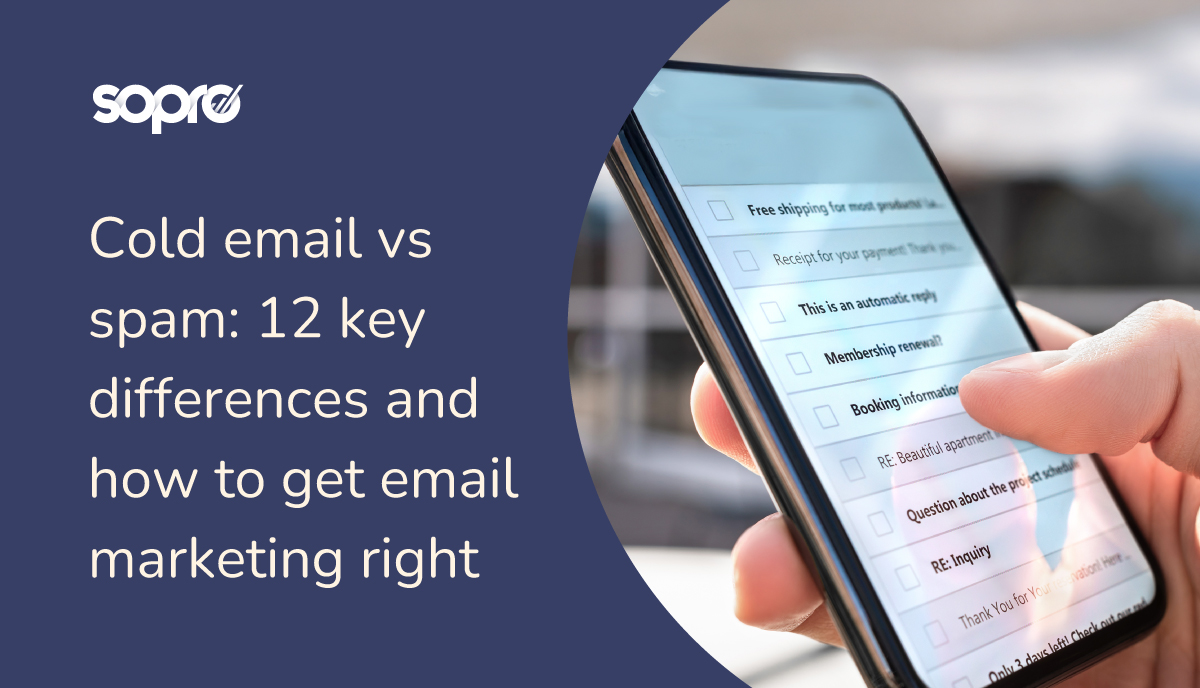Multi-channel reporting: a practical guide
In this blog
- The shift to multi-channel
- The email deliverability challenge
- The psychology behind multi-channel effectiveness
- Understanding the non-linear customer journey
- The holistic approach to ROI
- Beyond single-channel attribution: the influence factor
- Key metrics for effective multi-channel reporting
- The importance of company-level tracking
- Embrace the complexity for better results

This post will guide you through the fundamentals of multi-channel reporting, exploring why it’s become essential in modern outbound marketing.
I’ll break down the key metrics to track, the psychology behind multi-channel strategies, and how to handle attribution in complex customer journeys.
The shift to multi-channel
In today’s digital landscape, outbound marketing has evolved significantly.
It’s grown from a growth hacker tactic to one of (if not the) primary marketing channels for many companies. Alongside this development, the days of relying solely on one channel are behind us — and for good reason.
A multi-channel approach has become essential, not only for maximising reach but also for addressing key challenges that simpler outbound strategies often face. Let’s dive into why this shift is happening and how it affects our approach to reporting.
The email deliverability challenge
Before we get into the nitty-gritty of multi-channel reporting, it’s crucial to understand one of the main drivers behind this shift in outbound over the past few years: email deliverability.
Why email isn’t enough anymore
Email marketing, once the golden child of outbound strategies, is facing some real hurdles:
- Inbox providers have become increasingly selective about what they allow through.
- High-volume, low-quality senders have muddied the waters for everyone. Simply sending more is not the answer to falling deliverability.
- Your well-crafted messages are at higher risk of landing in spam folders or not being delivered at all.
This isn’t to say email is dead—far from it. But it does mean that more care and attention are needed in your outbound strategy. This is where multi-channel approaches come into play, enabling you to diversify your outreach, reduce the risks of over-relying on email, and better align with how buyers prefer to engage with your company.
The psychology behind multi-channel effectiveness
Multi-channel is not a new buzzword and has its roots firmly set in traditional marketing.
Complex buyer journeys
The ‘rule of seven’ is a marketing principle dating from the 1930s and states that a prospect needs to see or hear your message at least seven times before taking action. A 2020 study by FocusVision found that the average B2B buyer now reads 13 pieces of content before making a decision. While five of those are third-party pieces of content (reviews, comparisons, etc.), eight of them come from the brand itself.
Multi-channel approaches make it easier to achieve this frequency without becoming repetitive in a single channel.
The encoding variability hypothesis
This theory suggests that information is better remembered when presented in various contexts or formats. In multi-channel marketing, each channel provides a unique context for your message, and an opportunity to present in a different format.
Account based marketing success
A study by SiriusDecisions found that 91% of marketers saw higher ROI with ABM compared to traditional marketing strategies, largely because it includes coordinated touchpoints across channels.
Understanding the non-linear customer journey
One of the core principles of multi-channel marketing is that customers don’t follow a predetermined path.
You might have designed a world-class sequence of events that customers will follow, viewing your email before replying to your well-crafted LinkedIn invite—but in real life, it’s way more complex than that. They interact with your brand across various touchpoints according to their own preferences and timing.
A customer journey from initial contact through to sale could easily look something like this:
- See a LinkedIn ad
- Receive an email—do not respond
- Google your company name and visit the website (hello, organic traffic?)
- Receive a piece of direct mail
- View 12 more LinkedIn ads over the next few weeks
- Find themselves back on your website and start chatting with a rep over webchat
This non-linear path adds massive complexity to tracking and attribution—in the above example, which channel ultimately gets credit for the sale? However, tracking complexity should never trump customer experience—which is why it’s essential that your reporting is sophisticated enough to handle this.
The holistic approach to ROI
When measuring the success of multi-channel campaigns, it’s essential to look at the big picture first: what’s the total return on your total spend? Before optimising each channel, does outbound actually work for you? In order to do that, it’s a deceptively simple calculation of:
Total revenue earned / total investment
This calculates how many pounds or dollars you have earned per pound spent. There are some common pitfalls though—when calculating this north star metric, you need to make sure that all areas of both revenue and cost are considered.
Accounting for direct and indirect attribution
To get an accurate picture of your ROI, you need to start with the return and consider both direct and indirect attributions. These are leads that are directly attributable to outbound activity, such as:
1. Direct attribution:
- Email replies
- LinkedIn responses
- Phone call responses
And also leads that have happened as a result of outbound activity—but have actually been transacted elsewhere. We call these direct to CRM:
2. Indirect attribution (direct to CRM):
- Demo form submissions
- Webchat engagements
- Website conversions influenced by outbound efforts
By considering both types of attribution, you get a more comprehensive understanding of your campaign’s true revenue.
A similar logic applies to costs. Often, we see the marketing cost or investment reported as the cost of tooling, data, or ad spend, but not accounting for the very real cost of people required to manage and deliver that activity.
Beyond single-channel attribution: the influence factor
Multi-channel reporting isn’t just about attributing a lead to a single touchpoint. It’s about understanding how each channel influences the overall likelihood of buying.
This nuanced approach can reveal insights that simply do not exist in a traditional single-channel model of reporting. Here at Sopro, we are always running experiments with our own sales and marketing activity—both to improve our own pipeline but more importantly, as a feedback loop into product development. Two recent examples really demonstrate the impact of a multi-channel approach:
The unexpected impact of direct mail
In one of our campaigns, we ran a test where half of an audience was sent two letters, timed to roughly coincide with an email sequence, and the other half received just the email sequence. This test resulted in:
- A very low number of leads from the letter itself—fewer than 10 visits to a landing page and only one lead.
- A massive uplift in email response rates—the segment that had received the letters showed a 40% higher lead rate from the email activity.
This example shows how one channel can significantly boost the performance of another, even if it doesn’t directly generate a high number of conversions.
The LinkedIn effect
We’ve seen similar and more consistent results with LinkedIn advertising:
- Companies exposed to LinkedIn video ads were more likely to convert through other channels.
- Despite these ads not having a direct call-to-action, they played a crucial role in the customer journey.
Note that both of these takeaways are the results of experiments and are not necessarily the same for all campaigns. Your mileage may (and almost certainly will) vary, which is why getting the right reporting foundation in place is key.
Key metrics for effective multi-channel reporting
To effectively measure multi-channel campaigns, you need to be tracking these metrics as a baseline:
1. Activity-based metrics
What touchpoints each prospect receives, eg:
- Number of emails sent
- Number of LinkedIn connections
- Number of website visits
2. Channel influence metrics
Which channels have been involved in conversions, eg:
- Percentage of leads with LinkedIn touchpoints
- Percentage of leads with an email send or reply
- Percentage of leads that have a website visit
3. Channel-specific metrics
- Email: response rate and positive response rate
- LinkedIn: connection rate
Taking the channel influence metrics in #2 and dividing by the activity in #1 helps to give an indicator of the effectiveness of each channel, and where to focus efforts on optimisation first. Then the channel-specific metrics provide the necessary insights into each channel and how it can be improved.
Note: While comparing these metrics can provide insights into relative performance, remember that each channel has its own limitations—we see that webchat is a very effective channel when used correctly but it is much more difficult to increase the volume of chats than the number of emails, for example.
The importance of company-level tracking
While individual interactions are valuable to track, it’s crucial to analyse engagement at the company level. Even if you aren’t using an ABM approach—the company is still the real buyer here. We believe that all B2B activity is really ABM, and the metrics and reporting should reflect this. Key areas to consider are:
1. Multiple decision-makers
B2B buying decisions typically involve four or more people. Company-level tracking helps you gauge the impact of your messaging across the entire buying committee.
2. Comprehensive influence
This approach allows you to see how your multi-channel efforts are penetrating the organisation as a whole, rather than focusing on individual responses.
3. A longer-term approach to visibility
The average time in a role is 18 months—meaning that even relatively short sales cycles can be subject to stakeholders changing, and engagement activity being set back. Focusing at the company level really helps mitigate this.
Being able to track all channel metrics by company and combine them into an overall engagement score gives a focused view on how well you are working through your TAM.
Embrace the complexity for better results
Multi-channel reporting in outbound marketing is significantly more complex than single-channel approaches, and comes with many more advanced statistical models such as multi-variant testing. However, this complexity brings with it a wealth of insights and opportunities for optimisation. By adopting a holistic view of campaign performance, considering both direct and indirect attributions, and understanding the influence of each channel, you can create more effective, data-driven strategies.
Remember, the goal is not just to track conversions, but to understand the intricate customer journey, its varying lengths, and how each touchpoint contributes to the ultimate decision to engage with your brand.
If you’re interested in how Sopro’s multi-channel marketing agency could help you reach your entire audience and provide transparent reporting, while doing it, get in touch with our team today to find out more.
Or, if you’re looking for more guidance, take a look at our blog. Our experts have compiled guides on everything you need to know about lead generation on prospecting, including information on how to optimise your website lead generation campaigns, lead response times, and social media lead generation.







Share